Assessing the Energy Consumption and Driving Range of the QUIET Project Demonstrator Vehicle
Abstract
:1. Introduction
- HVAC system based on the refrigerant R290 (propane);
- Phase change material (PCM) thermal storage system;
- Infrared heating panels in the near field of the passengers;
- Redesigned seat internal structures using lightweight materials, such as aluminium and magnesium (15% weight reduction);
- Glass or carbon fibre composite vehicle doors with a novel APM aluminium foam (20% weight reduction and NVH optimisation);
- Human–machine interface (HMI) specialised on EVs for easy and efficient interaction with the thermal and energy management.
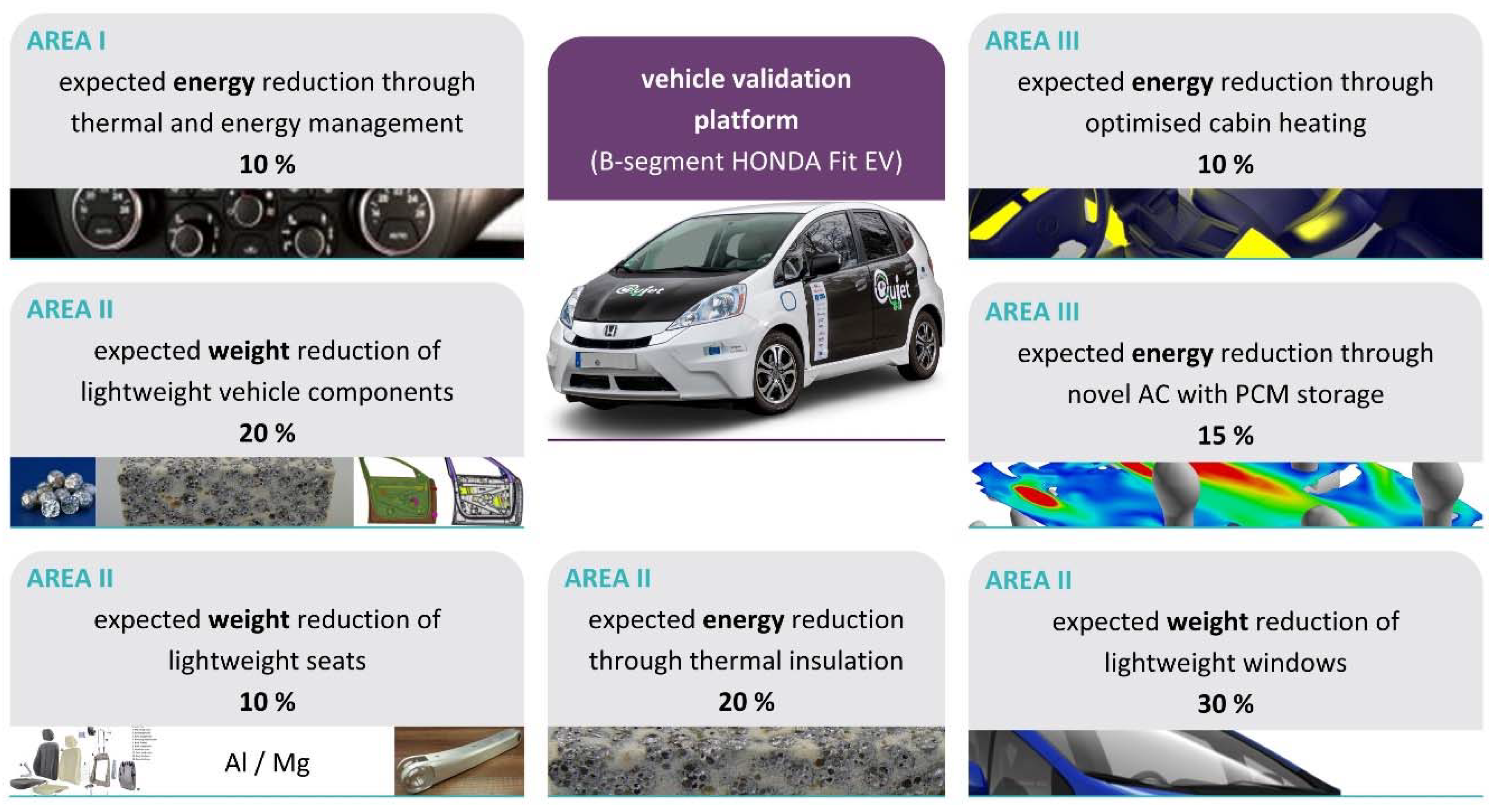
2. Overview of the Implemented Technologies
- Heat pump and propane
- Advanced Thermal Storage
- Lightweight materials and infrared radiative heating
- User-centric design and optimisation
3. Experimental Set-Up
3.1. Test Vehicle and Laboratory
- Vehicle-speed coupled blower;
- Driver’s aid system with a data logger for real-time acquisition of signals;
- Precision power analyser used for the electrical components;
- Flow controlling devices;
- Emission measurement system for gases, PM, and PN (raw and diluted emission).
3.2. Measurement Points
3.3. Test Driving Cycles
- The Mobile Air Conditioning (MAC) [42];
4. Results and Discussion
4.1. WLTP Consecutive Cycle Test Energy Consumption Results
4.1.1. Energy Consumption at 23 °C
4.1.2. Energy Consumption at −10 °C
4.1.3. Energy Consumption at 40 °C
4.2. MAC Test Energy Consumption Results
4.3. Driving Range Results
4.3.1. WLTP Consecutive Cycle Test Driving Range Results
4.3.2. Multi-Cycle Approach for Estimating the Driving Range
4.3.3. WLTP City Driving Range Results
5. Discussion and Conclusions
Author Contributions
Funding
Institutional Review Board Statement
Informed Consent Statement
Data Availability Statement
Acknowledgments
Conflicts of Interest
Abbreviations
| A/C | Air conditioning |
| AC | Alternating current |
| APM | Atomically Precise Manufacturing |
| BEV | Battery electric vehicle |
| CAN | Controller area network |
| CCT | Consecutive cycle test |
| CFD | Computational fluid dynamics |
| CSS | Constant speed segment |
| DC | Direct current |
| EM | Electric motor |
| GHG | Greenhouse gases |
| GPS | Global positioning system |
| GWP | Global warming potential |
| HC | Hydrocarbon |
| HMI | Human–machine interface |
| HV | High voltage |
| HVAC | Heating, ventilation, and air conditioning |
| HV-PTC | High-voltage positive thermal coefficient |
| ICE | Internal combustion engine |
| IFAM | Fraunhofer Institute for Manufacturing Technology and Advanced Materials |
| IR | Infrared |
| JRC | Joint Research Centre |
| MAC | Mobile air conditioning |
| NEDC | New European Driving Cycle |
| NVH | Noise Vibration Harshness |
| ODP | Ozone depleting potential |
| PCM | Phase change material |
| PM | Particulate mass |
| PMV | Predicted mean vote |
| PN | Particulate number |
| STP | Shortened test procedure |
| SUV | Sport utility vehicle |
| QUIET | QUalifying and Implementing a user-centric designed and EfficienT electric vehicle |
| VELA | Vehicle emission laboratories |
| WLTP | Worldwide harmonized Light-duty Test Procedure |
References
- European Commission. Paris Agreement COP21. 2015. Available online: https://ec.europa.eu/clima/policies/international/negotiations/paris_en (accessed on 6 December 2021).
- European Commission. European Green Deal. Available online: https://ec.europa.eu/commission/presscorner/detail/en/ip_19_6691 (accessed on 6 December 2021).
- European Commission. Sustainable and Smart Mobility Strategy–Putting European Transport on Track for the Future. 9 December 2020. Available online: https://eur-lex.europa.eu/legal-content/EN/TXT/?uri=CELEX:52020DC0789 (accessed on 6 December 2021).
- European Commission. Sustainable Mobility the European Green Deal. December 2021. Available online: https://ec.europa.eu/commission/presscorner/detail/en/fs_19_6726 (accessed on 6 December 2021).
- European Commission. Roadmap to a Single European Transport Area—Towards a Competitive and Resource Efficient Transport System. 28 March 2011. Available online: https://eur-lex.europa.eu/legal-content/EN/TXT/?uri=CELEX%3A52011DC0144 (accessed on 6 December 2021).
- E-Fools: Why E-Fuels in Cars Make No Economic or Environmental Sense. April 2021. Available online: https://www.bundestag.de/resource/blob/842490/8b933a33b2c9fdedac375996de237bbf/Artikel-1-Jekaterina-Boening-data.pdf (accessed on 6 December 2021).
- International Energy Agency (IEA). Global EV Outlook 2021. 2021. Available online: https://www.iea.org/reports/global-ev-outlook-2021 (accessed on 6 December 2021).
- Shafique, M.; Azam, A.; Rafiq, M.; Luo, X. Life cycle assessment of electric vehicles and internal combustion engine vehicles: A case study of Hong Kong. Res. Transp. Econ. 2021, 101112. [Google Scholar] [CrossRef]
- Shafique, M.; Luo, X. Environmental life cycle assessment of battery electric vehicles from the current and future energy mix perspective. J. Environ. Manag. 2022, 303, 114050. [Google Scholar] [CrossRef]
- Helmers, E.; Weiss, M. Advances and critical aspects in the life-cycle assessment of battery electric cars. Energy Emiss. Control Technol. 2017, 5, 1–18. [Google Scholar] [CrossRef] [Green Version]
- European Commission Directorate-General for Climate Policy Directorate C-Climate Strategy, Governance and Emissions from Non-Trading Sectors Unit C4—Road Transport. Determining the environmental impacts of conventional and alternatively fuelled vehicles through LCA. 2020. Available online: https://op.europa.eu/it/publication-detail/-/publication/1f494180-bc0e-11ea-811c-01aa75ed71a1 (accessed on 6 December 2021).
- Hyeon Park, M.; Chul Kim, S. Heating Performance Characteristics of High-Voltage PTC Heater for an Electric Vehicle. Energies 2017, 10, 1494. [Google Scholar] [CrossRef] [Green Version]
- Zhang, T.; Gao, C.; Gao, Q.; Wang, G.; Liu, M.; Guo, Y.; Xiao, C.; Yan, Y. Status and development of electric vehicle integrated thermal management from BTM to HVAC. Appl. Therm. Eng. 2015, 88, 398–409. [Google Scholar] [CrossRef]
- Paffumi, E.; Otura, M.; Centurelli, M.; Casellas, R.; Brenner, A.; Jahn, S. Energy Consumption, Driving Range and Cabin Temperature Performances at Different Ambient Conditions in Support to the Design of a User-Centric Efficient Electric Vehicle: The QUIET Project. In Proceedings of the 14th SDEWES Conference, Dubrovnik, Croatia, 1–6 October 2019; p. 18. [Google Scholar]
- De Gennaro, M.; Paffumi, E.; Martini, G.; Manfredi, U.; Vianelli, S.; Ortenzi, F.; Genovese, A. Experimental Test Campaign on a Battery Electric Vehicle: Laboratory Test Results (Part 1). Int. J. Altern. Powertrains 2015, 4, 1. [Google Scholar] [CrossRef]
- De Gennaro, M.; Paffumi, E.; Martini, G.; Scholz, H. A pilot study to address the travel behaviour and the usability of electric vehicles in two Italian provinces. Case Stud. Transp. Policy 2014, 2, 116–141. [Google Scholar] [CrossRef]
- DeGennaro, M.; Paffumi, E.; Martini, G. Big Data for Supporting Low-Carbon Road Transport Policies in Europe: Applications, Challenges and Opportunities. Big Data Res. 2016, 6, 11–25. [Google Scholar] [CrossRef]
- Paffumi, E.; Wang, J.; Nunnendorf, V.; Jahn, S. Quiet Deliverable D5.4. QUIET-QUalifying and Implementing a User-Centric Designed and EfficienT Electric Vehicle. 2021. Available online: https://www.quiet-project.eu/wp-content/uploads/2021/06/QUIET-D54_public_HP.pdf (accessed on 6 December 2021).
- QUIET-QUalifying and Implementing a User-Centric Designed and EfficienT Electric Vehicle. Quiet Flyer. 2021. Available online: https://www.quiet-project.eu/wp-content/uploads/2021/04/flyer.pdf (accessed on 6 December 2021).
- Wei, C.; Hofman, T.; Caarls, E.I.; van Iperen, R. A Review of the Integrated Design and Control of Electrified Vehicles. Energies 2020, 13, 5454. [Google Scholar] [CrossRef]
- Cvok, I.; Ratković, I.; Deur, J. Optimisation of Control Input Allocation Maps for Electric Vehicle Heat Pump-based Cabin Heating Systems. Energies 2020, 13, 5131. [Google Scholar] [CrossRef]
- Cvok, I.; Ratković, I.; Deur, J. Multi-Objective Optimisation-Based Design of an Electric Vehicle Cabin Heating Control System for Improved Thermal Comfort and Driving Range. Energies 2021, 14, 1203. [Google Scholar] [CrossRef]
- A European Union Funded Project Coordinated by AIT Austrian Institute of Technology. Quiet Web Page. Available online: https://www.quiet-project.eu/media/ (accessed on 6 December 2021).
- European Commission. Vehicle Emissions Laboratories. Available online: https://ec.europa.eu/jrc/en/research-facility/vehicle-emissions-laboratory-vela (accessed on 6 December 2021).
- Drage, P.; Hinteregger, M.; Zotter, G.; Šimek, M. Cabin Conditioning for Electric Vehicles. ATZ Worldw. 2019, 121, 44–49. [Google Scholar] [CrossRef]
- Kim, K.Y.; Kim, S.C.; Kim, M.S. Experimental studies on the heating performance of the PTC heater and heat pump combined system in fuel cells and electric vehicles. Int. J. Automot. Technol. 2012, 13, 971–977. [Google Scholar] [CrossRef]
- Shrivastava, A.P.; Dahake, M.R. Performance Analysis of Automobile Air Conditioning System using Propane (R290). Int. Res. J. Eng. Technol. (IRJET) 2016, 3, 1344–1347. [Google Scholar]
- Kandhaswamy, K.; Periasamy, S.; Maylsamy, S.; Thangavel, S. Experimental investigations on automobile air conditioners working with R134a and R290/R600a as an alternative. Therm. Sci. 2017, 21, 515–522. [Google Scholar] [CrossRef] [Green Version]
- Osterman, E.; Tyagi, V.; Butala, V.; Rahim, N.; Stritih, U. Review of PCM based cooling technologies for buildings. Energy Build. 2012, 49, 37–49. [Google Scholar] [CrossRef]
- Souayfane, F.; Fardouna, F.; Biwole, P.-H. Phase change materials (PCM) for cooling applications in buildings: A review. Energy Build. 2016, 129, 396–431. [Google Scholar] [CrossRef]
- Jha, K.K.; Badathala, R. Low Temperature Thermal Energy Storage (TES) System for Improving Automotive HVAC. Technical Report for SAE 2015World Congress & Exhibition. 2015. Available online: https://www.sae.org/publications/technical-papers/content/2015-01-0353/ (accessed on 6 December 2021).
- LaClair, T.; Gao, Z.; Abdelaziz, O.; Wang, M.; Wolfe, E.; Craig, T. Thermal Storage System for Electric Vehicle Cabin Heating-Component and System Analysis. Technical Report for SAE 2016 World Congress and Exhibition. 2016. Available online: https://www.sae.org/publications/technical-papers/content/2016-01-0244/ (accessed on 6 December 2021).
- Baumeister, J.; Weise, J.; Myslicki, S.; Kieseritzky, E.; Lindenberg, G. PCM-Based Energy Storage System with High Power Output Using Open Porous Aluminum Foams. Energies 2020, 13, 23. [Google Scholar] [CrossRef]
- Jeffs, J.; McGordon, A.; Picarelli, A.; Robinson, S.; Tripathy, Y.; Widanage, W.D. Complex Heat Pump Operational Mode Identification and Comparison for Use in Electric Vehicles. Energies 2018, 11, 2000. [Google Scholar] [CrossRef] [Green Version]
- Lahlou, A.; Ossart, F.; Boudard, E.; Roy, F.; Bakhouya, M. Optimal Management of Thermal Comfort and Driving Range in Electric Vehicles. Energies 2020, 13, 17. [Google Scholar] [CrossRef]
- Lahlou, A.; Ossart, F.; Boudard, E.; Roy, F.; Bakhouya, M. A Real-Time Approach for Thermal Comfort Management in Electric Vehicles. Energies 2020, 13, 15. [Google Scholar] [CrossRef]
- Basciotti, D.; Dvorak, D.; Gella, I. A Novel Methodology for Evaluating the Impact of Energy Efficiency Measures on the Cabin Thermal Comfort of Electric Vehicles. Energies 2020, 13, 3872. [Google Scholar] [CrossRef]
- “Quiet Deliverables D3.1 D3.2 D3.3,” QUIET-QUalifying and Implementing a User-Centric Designed and EfficienT Electric Vehicle. 2021. Available online: https://www.quiet-project.eu/dissemination/ (accessed on 6 December 2021).
- Paffumi, E.; De Gennaro, M.; Martini, G.; Manfredi, U.; Vianelli, S.; Ortenzi, F.; Genovese, A. Experimental Test Campaign on a Battery Electric Vehicle: On-Road Test Results (Part 2). SAE Int. J. Altern. Powertrains 2015, 4, 2. [Google Scholar] [CrossRef]
- American Honda Motor Co. Honda Fit EV Emergency Response Guide. 2012. Available online: https://techinfo.honda.com/rjanisis/pubs/web/ACI48132.pdf (accessed on 6 December 2021).
- American Honda Motor Co., Inc. 2013–2014 Fit EV Online Reference Owner’s. 2012. Available online: http://techinfo.honda.com/rjanisis/pubs/OM/AH/AX91414OM/enu/X91414OM.PDF (accessed on 6 December 2021).
- DG Enterprise and Industry under Framework Service Contract ENTR/05/18/2010. MAC Test Procedure to Be Used in a Pilot Phase, Final Report of the Project “Collection and Evaluation of Data and Development of Test Procedures in Support of Legislation on Mobile Air Conditioning (MAC) Efficiency and Gear Shift Indicators (GSI)”. 2010. Available online: http://www.unece.org/fileadmin/DAM/trans/doc/2010/wp29grpe/MACTP-01-06e.pdf (accessed on 6 December 2021).
- UNECE. Global Technical Regulation No. 15 Worldwide Harmonized Light Vehicles Test Procedure. 2014. Available online: https://www.unece.org/fileadmin/DAM/trans/main/wp29/wp29r-1998agr-rules/ECE-TRANS-180a15e.pdf (accessed on 6 December 2021).
- European Commission. Commission Regulation (EU) 2017/1151. Available online: https://eur-lex.europa.eu/legal-content/EN/TXT/?uri=celex%3A32017R1151 (accessed on 6 December 2021).
- Environmental Protection Agengy (EPA). EV Label. 2019. Available online: https://fueleconomy.gov/ (accessed on 6 December 2021).
- Meyer, N.; Whittal, I.; Christenson, M.; Loiselle-Lapointe, A. The impact of the driving cycle and climate on electrical consumption and range of fully electric passengers vehicles. In Proceedings of the EVS26-International Battery, Hybrid and Fuel Cell Electric Vehicle Symposium, Los Angeles, CA, USA, 6–9 May 2012. [Google Scholar]
- SAE International Surface Vehicle Recommended Practice. Battery Electric Vehicle Energy Consumption and Range Test Procedure. SAE Standard J1634. 2012. Available online: https://www.sae.org/standards/content/j1634_201210/ (accessed on 6 December 2021).

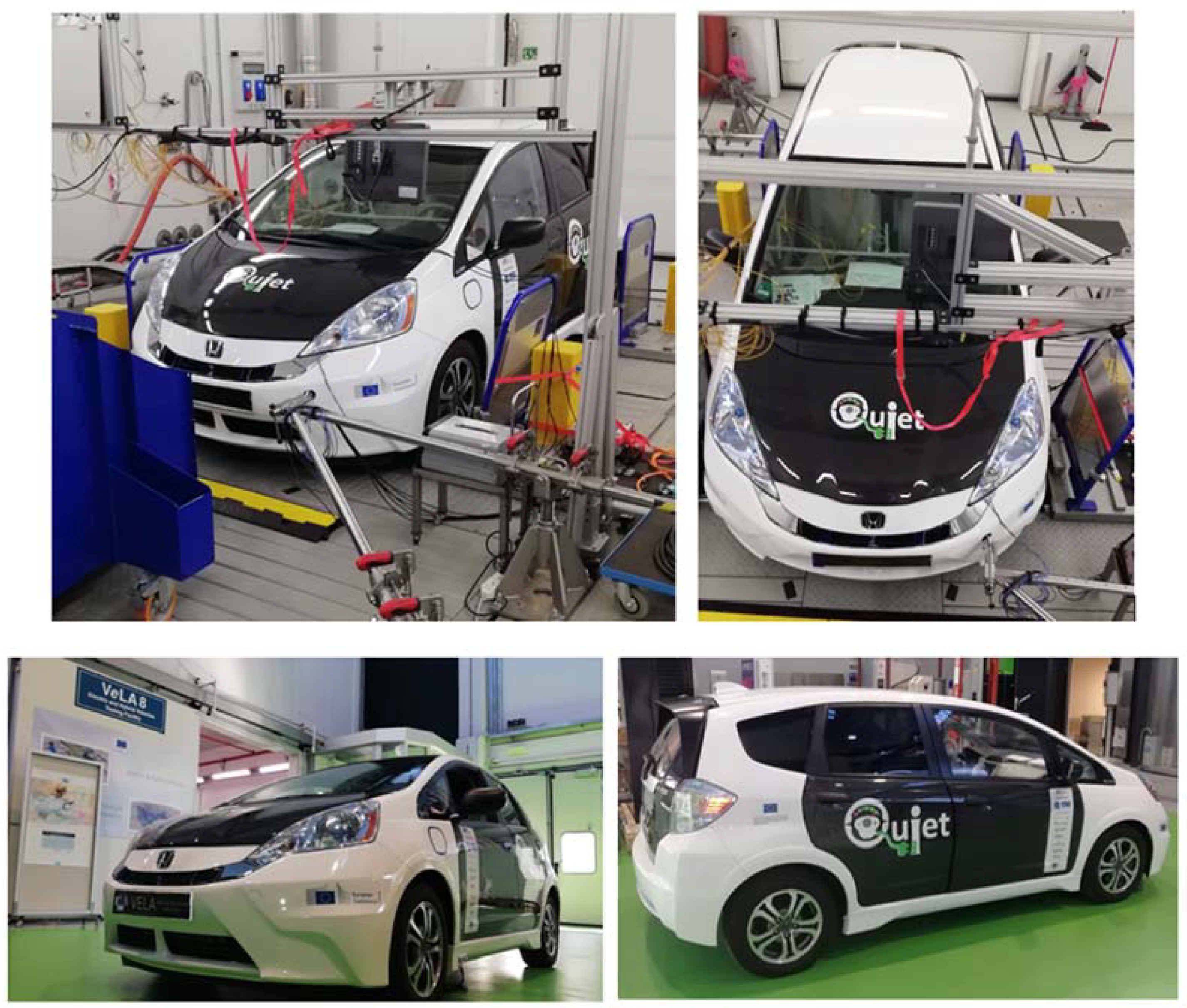
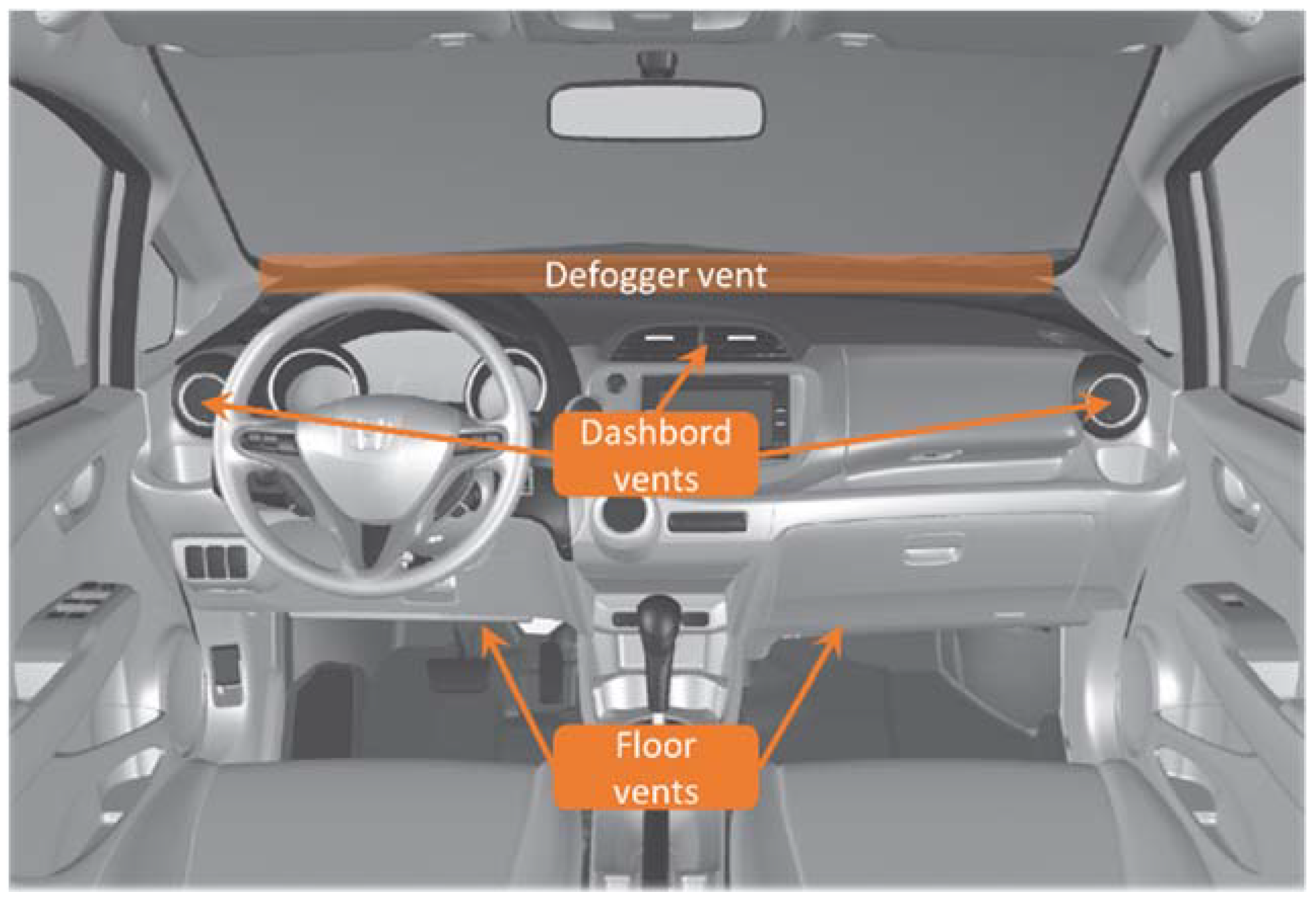


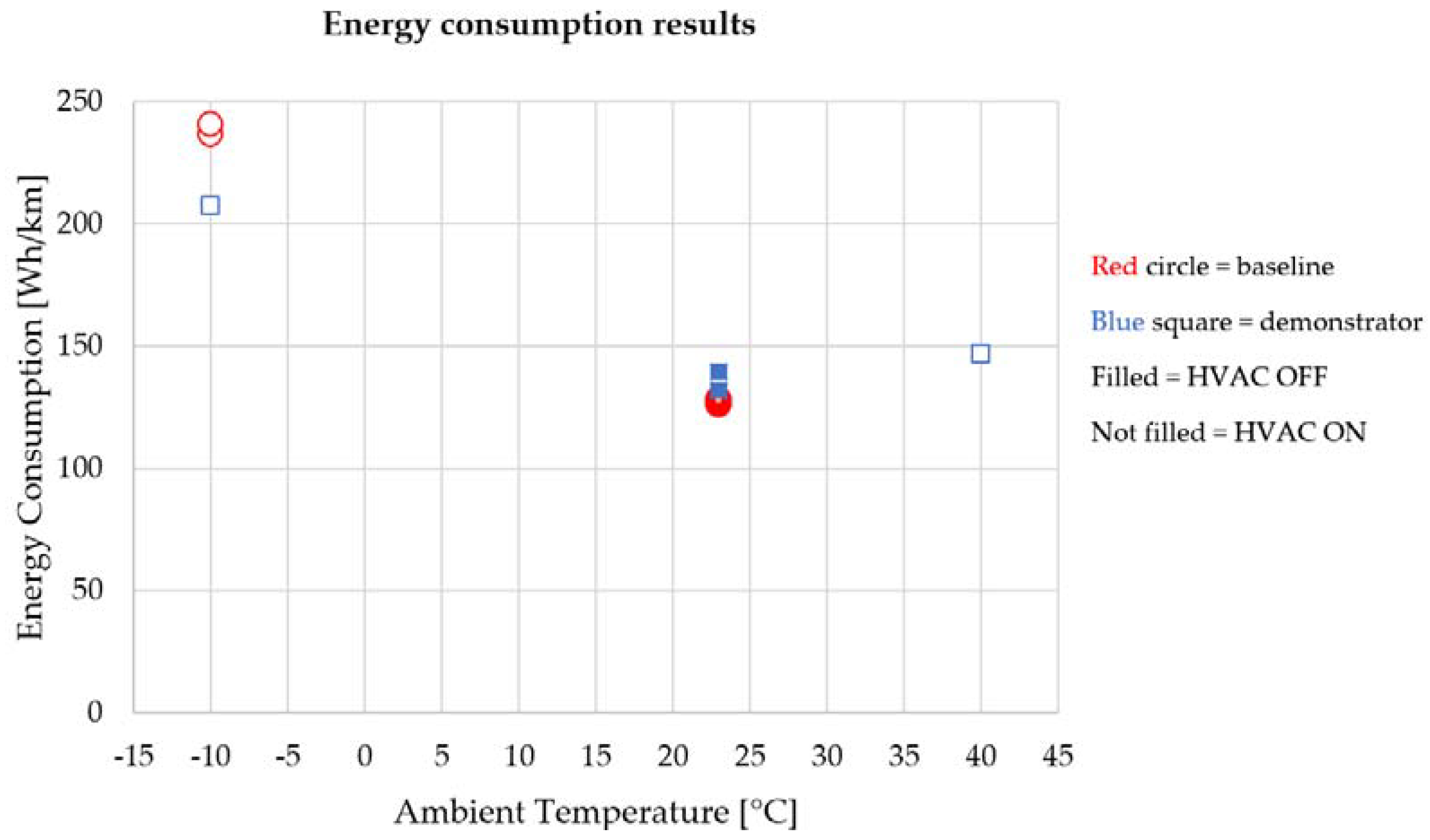
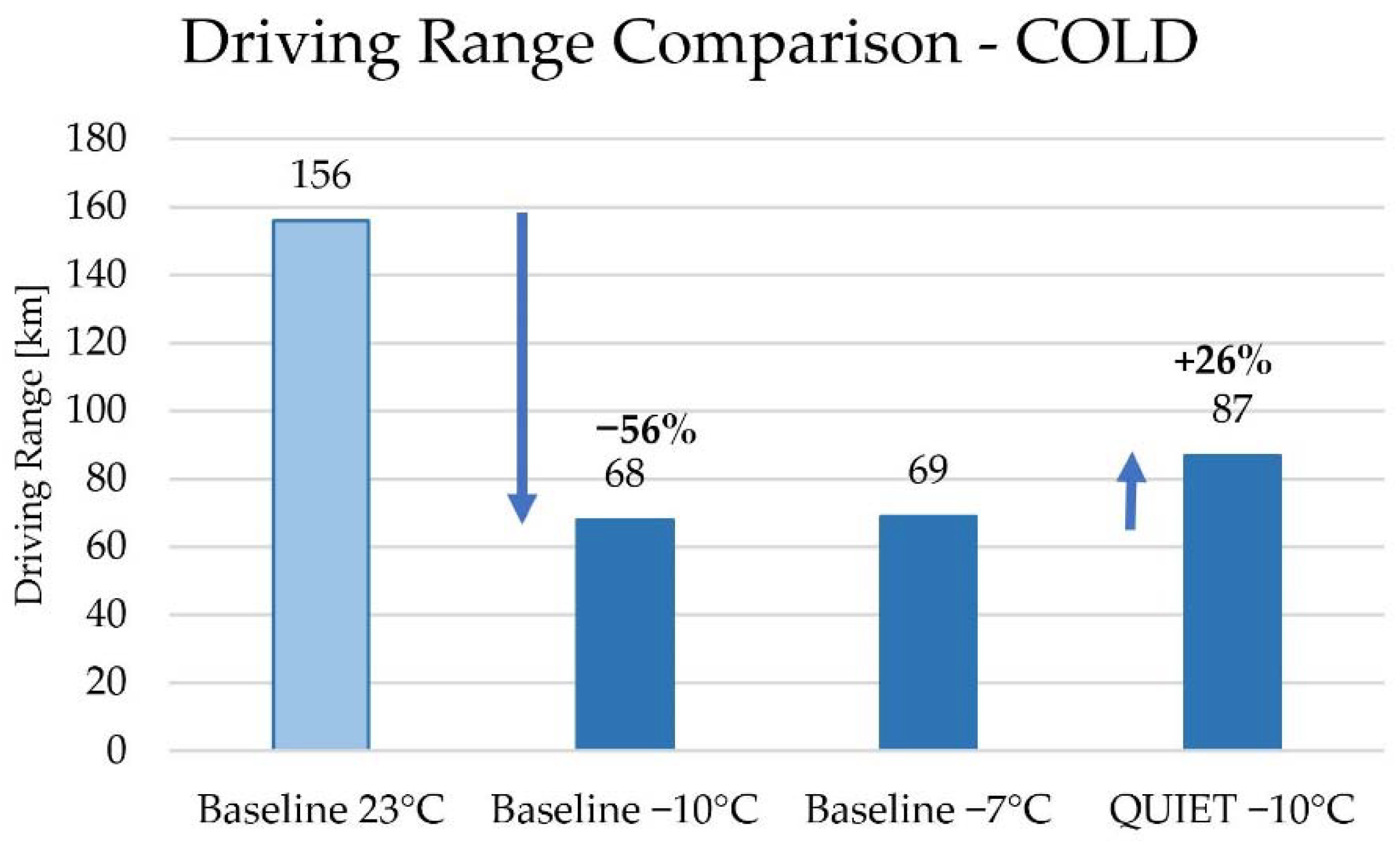

| Architecture | Vehicle Demonstrator |
|---|---|
| Propulsion | Synchronous electric motor |
| Max. Power (kW) | 75 |
| Max. Torque (N∙m) | 256 |
| Mass (kg) | 1540 |
| Battery | 20 kWh–432 Li-Ion cells 331 V (nominal voltage) |
| Measurement Point Label | Description |
|---|---|
| M1 | Energy from the grid to the high-voltage battery (Wh) (acquired directly on the recharging station) |
| M2 | Current (A) and Voltage (V), from the high-voltage battery feeding the inverter, the low-voltage auxiliary systems, and the heating and A/C systems (acquired both by CANbus and current clamp measurements) |
| M3 | Rotational speed (rpm) and torque (N∙m) of the electric motor (acquired by CANbus) |
| M4 | Energy at the wheel (Wh) (acquired by the dyno) |
| M5 | Current (A) and Voltage (V), from the high-voltage battery to the heater (acquired by CANbus) |
| M6 | Current (A) and Voltage (V), from the high-voltage battery to the A/C compressor (acquired both by CANbus and current clamp measurement) |
| Cycle | Ambient Temperature | HVAC |
|---|---|---|
| WLTP CCT | 23 °C | off |
| WLTP CCT | −10 °C | AUTO mode 2 seats occupied 25 °C enforced (heating) |
| WLTP CCT | 40 °C | AUTO mode 2 seats occupied 26 °C enforced (cooling) |
| WLTP STP | 23 °C | off |
| MAC | 25 °C | AUTO mode 2 seats occupied 15 °C enforced (cooling) |
| MAC | −10 °C | AUTO mode 2 seats occupied 22 °C enforced (heating) |
| TAmb. = 23 °C HVAC OFF | Demonstrator Tests | Baseline Tests (Rep. #1) | ||
|---|---|---|---|---|
| Case 1 | Case 2 | Case 1 | Case 2 | |
| WLTC (Wh/km) (l/100 km) | WLTC (Wh/km) (l/100 km) | WLTC (Wh/km) (l/100 km) | WLTC (Wh/km) (l/100 km) | |
| Cycle 1 combined | 136.0 (1.53) | 138.2 (1.55) | 131.3 (1.47) | 128.7 (1.43) |
| Cycle 2 combined | 131.0 (1.47) | 137.9 (1.54) | 129.6 (1.46) | 126.7 (1.41) |
| Cycle 3 combined | 130.4 (1.46) | 138.4 (1.55) | 129.4 (1.45) | 127.4 (1.42) |
| Cycle 4 combined | 132.8 (1.49) | 139.7 (1.57) | 129.2 (1.45) | 127.0 (1.41) |
| Cycle 5 combined | 130.8 (1.47) | 138.4 (1.55) | 130.7 (1.47) | 128.5 (1.43) |
| Cycle 6 combined | / | / | 131.9 (1.48) | 128.8 (1.43) |
| Total from start up to break-off criteria combined | 131.6 (1.48) | 139.4 (1.57) | 128.6 (1.44) | 125. (1.40) |
| Total from start up to break-off criteria WLTP (K-weighted values) | 133.1 (1.50) | 138.5 (1.56) | 130.3 (1.46) | 127.8 (1.44) |
| Rec. Ratio (Battery) | 22.9% | 22.9% | 24.3% | 25.5% |
| TAmb. = −10 °C HVAC ON | Baseline Vehicle Tests (Rep. #3) | |
|---|---|---|
| Case 1 | Case 2 | |
| WLTC (Wh/km) (l/100 km) | WLTC (Wh/km) (l/100 km) | |
| Cycle 1 combined | 258.9 (2.91) | 264.6 (2.97) |
| Cycle 2 combined | 227.6 (2.56) | 233.2 (2.62) |
| Total from start up to break-off criteria combined | 235.9 (2.65) | 186.8 (2.10) |
| Total from start up to break-off criteria WLTP (K-weighted values) | 240.5 (2.70) | 249.9 (2.81) |
| Rec. Ratio (Battery) | 8.9% | 6.9% |
| TAmb. = −10 °C HVAC OFF | Demonstrator Tests | |
|---|---|---|
| Case 1 | Case 2 | |
| WLTC (Wh/km) (l/100 km) | WLTC (Wh/km) (l/100 km) | |
| Cycle 1 combined | 159.42 (1.79) | 163.36 (1.83) |
| Cycle 2 combined | 145.88 (1.64) | 149.91 (1.68) |
| Total from start up to break-off criteria combined | 140.79 (1.58) | 144.70 (1.63) |
| Total from start up to break-off criteria WLTP (K-weighted values) | 152.63 (1.71) | 156.59 (1.76) |
| Rec. Ratio (Battery) | 18.15% | 18.15% |
| Demonstrator Vehicle | Baseline Vehicle | ||||||
|---|---|---|---|---|---|---|---|
| Case 1 | Case 2 | Case 1 | Case 2 | Case 1 | Case 2 | ||
| MAC (Wh/km) (l/100 km) | MAC (Wh/km) (l/100 km) | MAC (Wh/km) (l/100 km) | MAC (Wh/km) (l/100 km) | MAC (Wh/km) (l/100 km) | MAC (Wh/km) (l/100 km) | ||
| TAmb. = 25 °C | Phase 1 HVAC ON | 175.8 (1.97) | 168.6 (1.89) | 172.7 (1.94) | 171.3 (1.92) | 143.3 (1.61) | 117.1 (1.32) |
| Phase 2 HVAC ON | 155.1 (1.74) | 148.8 (1.67) | 153.6 (1.73) | 152.9 (1.71) | 140.9 (1.58) | 107.6 (1.21) | |
| Phase 3 HVAC OFF | 131.1 (1.47) | 116.7 (1.31) | 134.2 (1.51) | 130.2 (1.46) | 128.1 (1.44) | 96.0 (1.08) | |
| Ratio | +18.3% | +27.5% | +14.4% | +17.4% | +10.0% | +12.1% | |
| TAmb. = −10 °C | Phase 1 HVAC ON | / | / | / | / | 301.7 (3.39) | 298.9 (3.36) |
| Phase 2 HVAC ON | / | / | / | / | 237.3 (2.66) | 234.0 (2.63) | |
| Phase 3 HVAC OFF | / | / | / | / | 146.7 (1.65) | 136.9 (1.54) | |
| Ratio | / | / | / | / | +61.7% | +71.0% | |
| Demonstrator Test | Baseline Tests | ||||||||
|---|---|---|---|---|---|---|---|---|---|
| Case 1 | Case 2 | Case 1 | Case 2 | Case 1 | Case 2 | Case 1 | Case 2 | ||
| Driving Range (km) | Driving Range (km) | Driving Range (km) | Driving Range (km) | ||||||
| TAmb. = 23 °C HVAC OFF | WLTP CCT up to break-off K-weighted | 136.08 | 136.44 | 154.43 | 154.10 | 154.74 | 124.10 | 149.24 | 148.90 |
| WLTP CCT up to break-off Not weighted | 136.61 | 156.50 | 156.78 | 148.76 | |||||
| TAmb. = −10 °C HVAC ON | Estimated WLTP CCT up to break-off Not weighted | 86.8 | 68 | 63.98 | 63.93 | ||||
| TAmb. = 40 °C HVAC ON | Estimated WLTP CCT up to break-off Not weighted | 137–140 | 137 | / | / | ||||
| Demonstrator Tests | Baseline Tests | ||||
|---|---|---|---|---|---|
| WLTC 23 °C HVAC OFF (km) | WLTC −10 °C HVAC OFF (km) | WLTC −10 °C HVAC ON (km) | WLTC 23 °C HVAC OFF (km) | WLTC −10 °C HVAC ON (km) | |
| Cycle 1 | 147.04 | 125.46 | 111.66 | 152.37 | 77.26 |
| Cycle 2 | 152.64 | 137.10 | / | 154.37 | 87.88 |
| Cycle 3 | 153.36 | / | / | 154.55 | / |
| Cycle 4 | 150.61 | / | / | 154.77 | / |
| Cycle 5 | 152.94 | / | / | 152.99 | / |
| Cycle 6 | / | / | / | 151.64 | / |
| WLTP CCT | 136 | 51 | 26 | 156 | 68 |
Publisher’s Note: MDPI stays neutral with regard to jurisdictional claims in published maps and institutional affiliations. |
© 2022 by the authors. Licensee MDPI, Basel, Switzerland. This article is an open access article distributed under the terms and conditions of the Creative Commons Attribution (CC BY) license (https://creativecommons.org/licenses/by/4.0/).
Share and Cite
Patrone, G.L.; Paffumi, E.; Otura, M.; Centurelli, M.; Ferrarese, C.; Jahn, S.; Brenner, A.; Thieringer, B.; Braun, D.; Hoffmann, T. Assessing the Energy Consumption and Driving Range of the QUIET Project Demonstrator Vehicle. Energies 2022, 15, 1290. https://doi.org/10.3390/en15041290
Patrone GL, Paffumi E, Otura M, Centurelli M, Ferrarese C, Jahn S, Brenner A, Thieringer B, Braun D, Hoffmann T. Assessing the Energy Consumption and Driving Range of the QUIET Project Demonstrator Vehicle. Energies. 2022; 15(4):1290. https://doi.org/10.3390/en15041290
Chicago/Turabian StylePatrone, Gian Luca, Elena Paffumi, Marcos Otura, Mario Centurelli, Christian Ferrarese, Steffen Jahn, Andreas Brenner, Bernd Thieringer, Daniel Braun, and Thomas Hoffmann. 2022. "Assessing the Energy Consumption and Driving Range of the QUIET Project Demonstrator Vehicle" Energies 15, no. 4: 1290. https://doi.org/10.3390/en15041290








